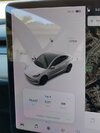If you're basing this off Stats, know that their calculation of rated miles was temperature affected up until Jan of this year. Then they switched SOC apis so that the rated miles is no longer affected. So, did this change in commute and rated miles occur sometime in late January?Hey all,
I just wanted to post my experience as a data point and get the group's thoughts on my theory. I have a 2020 model 3 AWD. My charging set up is a HPWC and I charge daily or every other day, with only 1 supercharging session ever. My daily commute used to be fairy short, about 20 miles round trip, and so the battery was typically between 50%-80% all of the time We took my wife's Y for long trips so the 3 has never really seen a long trip. The rated miles started around 310, and I honestly don't recall if I ever saw higher than that after the software bump. However, I did see a fairly sharp decline around 7000 miles on the odometer to a nadir of about 275 miles at 100% (projected at a charge of about 80%) I was mildly concerned about this but due to the car's use as above it wouldn't really affect me at all. Lately my daily commute has grown significantly to 108 miles round trip daily. With this, Ive seen a steady increase in my rated miles up to 305 miles today at 100% (projected).
The other interesting point is my efficiency used to be absurdly high (115-125%) that by stats put me better than 97% of users. With the increase in my rated miles, my efficiency has dropped to around 100%.
TLDR
1. With a large increase in my daily commute my rated miles have increased from 279--->305
2. Efficiency has dropped over this time as well
My question is could a very high efficiency be a clue that there are more rated miles than the battery meter is showing? I realize there are numerous factors affecting efficiency (driving style and weather) but it may provide an interesting data point for those who have low rated miles and are curious if it is a true reading or not
P.S. The weather did get much warmer from when the rated miles were 278 until 305 but I did not see the significant increase until my commute lengthened.
Here's my Stats rated miles, and it varied with the seasons, until end of January when the SOC api changed. Now it shows rated miles, regardless of temps.



